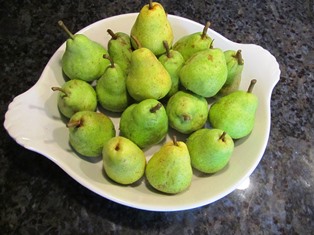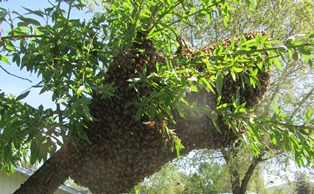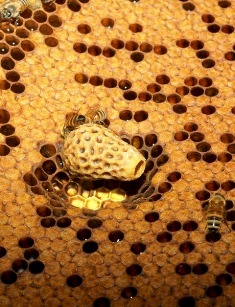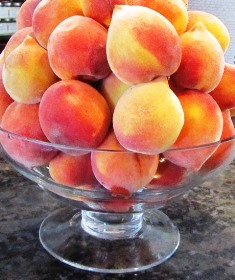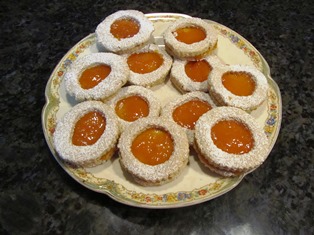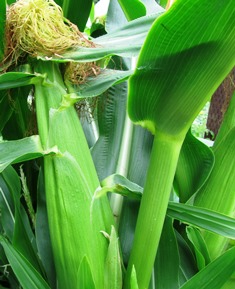Archive for July, 2013
Bartlett Pears Are Ready to Pick Now
Bartlett pears are ready to pick in July and August. The fruit should be picked from two to seven days before you plan to use it. Choose pears on the tree that are fragrant and green. There shouldn’t be any soft spots or mushiness.
Pluck the pears and put them in a paper bag in your kitchen. Add a banana or apple as the ethylene gas will help the pears ripen. You’ll want to poke some holes in the bag and fold over the top. Check the pears often to see how they are ripening.
Pears will reach their peak and be perfect for eating or using in cooking for about two days. When the top of the pear (where the stem is located) yields slightly when pressed, you’ll know the pear is at its peak. Don’t wait until the fruit feels soft all over, it’s past its peak and will be mushy.
Bartlett pears taste terrific grilled, made into pear butter, or baked into pie. They also taste great when eaten raw. But these pears are not the type you can pick off the tree and eat. They really need to ripen first and, as I’ve already pointed out, the best way to do that is in your kitchen.
Honeybees Have Distinct Personalities
I don’t wear perfume in the garden least the bees think I’m a flower and light on me. But if they do, I let them walk around and explore. I don’t swat at them. Why would I? Honeybees are generally among the most docile of all bees.
Honeybees also have different personality types, according to research published in 2012 in the magazine Science and based on a study by Gene Robinson, University of Illinois entomology professor and director of the Institute for Genomic Biology. See, http://news.illinois.edu/news/12/0308bees_GeneRobinson.html
Scavenging and reconnaissance work carries more risk and challenge, whether you are human or honeybee. An adventuresome personality is usually best suited for that kind of work. Robinson and his researchers observed that the honeybees that do the nest and food scouting express distinct patterns of gene activity in molecular pathways that have been associated with thrill-seeking.
Whereas the adventurous scouts choose the thrill of taking off, the more intrepid and timid bees tend to stick closer to home, doing the tasks of building the hive, cleaning it, caring for the babies, and making honey. Robinson’s research debunks the ages-old idea that the colony’s workers are interchangeable.
America’s first honeybees arrived in from Europe by ship to the American colonies in the 17th century. It took approximately 200 years for the honeybees to get to the West Coast from that early introduction. Some went feral. See, http://www.orsba.org/htdocs/download/Honey%20Bees%20Across%20America.html
The most aggressive honeybee personality is the Africanized bee (aka, killer bees). These bees attack (often in droves) if they perceive a threat to their nest or queen. See, http://www.independent.ie/world-news/americas/couple-attacked-by-swarm-of-30000-bees-who-kill-their-two-horses-29456104.html
The Africanized bees have spread from Brazil, where honeybees from Europe (highly valued for pollinating crops and producing honey) were interbred with bees from Africa. These bees were inadvertently released in the 1950’s in Brazil and began to migrate north. They are now in Texas, New Mexico, Nevada, Arizona, and California. See, http://bees.ucr.edu/ahb-facts.html
All this information about work and personality types as it relates to honeybees makes me wonder: If we humans suited our work to our personality types, would we work as contentedly as do the bees in the garden and those in the hive?
Paper Wasps Under the Eaves
The small, yellow-striped paper wasps have built two nests under the eaves. These insects are considered agriculturally beneficial, but they tend to get a little too close for comfort. The nests are right above my front door.
The nests are open-cell structures held together by fibers that the queen has masticated from wood posts (and sometimes woody plant stems) and mixed with saliva to create the cells of the nest. The nest can be grow to six to eight inches across in order to accommodate a growing population.
Paper wasps feed their offspring caterpillars, beetle larvae, corn earworms, flies, tobacco hornworms, armyworms, and other insects.
These wasps can sting multiple times, unlike the gentle honeybee that can sting only once. Earlier this year, when we were working on our front windows and door, I was stung four times on my cheek. For people allergic to bee stings, the sting can be life-threatening. It’s recommended to wear a bee suit when removing the nest as the wasps will attack in response to the threat to their nest.
The best time to remove the nest is evening when the wasps are less active and on the nest. High pressure water can be used to knock down the nest. I wrapped a hand towel saturated with a strongly scented kitchen cleaner. I took the nests down and then quickly went back into the house. The next day, a random paper wasp was back, apparently ready to rebuild. What was I to do, but reapply the smelling kitchen cleaner. The wasps are gone now.
Fresh Peaches Make Yummy Upside Down Cake
When our Desert Gold peach trees produced a few peaches at the end of May, we picked and ate all of them.
Now it’s the middle of July, and the Elberta peaches have ripened. Many have fallen from the tree. Over the last week, I picked most of those yellow-fleshed, honey sweet fruits and made peach preserves. With the remaining peaches hanging on the tree and about to drop, I am going to make a peach upside down cake.
The recipe looks long, but it is easy to follow and the cake is reminiscent of the upside down cake my grandmother used to make on her farm, located between Columbia and Booneville, in central Missouri. She always served it with homemade ice cream, made from fresh (cow’s milk) cream. For a quick substitute, you can use a quality vanilla ice cream to complement the taste of the warm peach cake.
Peach Upside Down Cake
Ingredients:
Three to four large peaches, peeled, stone removed, and sliced to produce 2 cups of fruit
½ cup light brown sugar, packed
1 teaspoon cinnamon
3 Tablespoons butter
1 ¾ cup all-purpose white flour
¼ teaspoon of salt
2 teaspoons baking powder
½ teaspoon cinnamon
½ cup butter (room temperature)
¾ cup granulated sugar
2 large eggs
½ teaspoon vanilla extract
¼ teaspoon almond extract
2/3 cup milk
Directions:
Preheat oven 325 degrees Fahrenheit
Grease a 9-inch square cake pan with butter.
Wash, peel, and remove pits of peaches; cut peaches into thin slices.
Combine brown sugar, 1 teaspoon of cinnamon, and 3 Tablespoons melted butter.
Add the peaches and toss to coat.
Arrange the peach mixture in the prepared baking pan.
Directions for making the cake batter:
Combine the flour, salt, baking powder, and ½ teaspoon cinnamon in a bowl.
Cream butter and sugar in a separate bowl and add eggs, vanilla extract, and almond flavoring.
Beat until well mixed.
Add the flour mixture to the creamed butter and sugar mixture, alternating with the milk, beating after each addition to blend.
Assembling:
Spoon the cake batter over the peach slices taking care to spread evenly until peaches are all covered.
Bake for 55 to 65 minutes. A toothpick inserted in the center of the cake should come out clean.
Remove from oven and invert onto a cake plate. Allow 5 minutes for the cake to pull away from the pan and drop onto the plate. Then gently remove the cake pan. Scrape any peach slices stuck in the pan onto top of cake.
Serves six.
Honeybee Disorders and Diseases
The beleaguered honeybee is threatened from environmental stresses, pests, and diseases that not only can decimate the bees but continually challenge modern beekeepers who must figure out how best to treat the problems.
Beekeepers against the use of chemicals within the hive believe there are other options available for dealing with these challenges such as breeding stronger, more resistant bees. That can take years. Meanwhile, it is important to understand some of the problems that can assail a hive.
Chalkbrood
When you see a frame within the hive containing larvae that have turned chalky white, consider that you are likely dealing with chalkbrood. Infection is by a fungus, Ascosphaera apis, causing the larva to die after its cell has been capped. Only the larvae are susceptible. Healthy hives of bees can usually clean up the problem on their own. Re-queening the hive and rotating out the old comb comprise the best course of treatment.
Nosema
Nosema cerrane is a fungus infection of the adult bee, affecting the intestinal tract that results in diarrhea. The disease can weaken the bees and diminish the health of a hive. Heathy hives can usually fend off and recover from Nosema, but hives that are already week are more susceptible to Nosema infection.
Tracheal Mites
Tracheal mites infect the trachea (windpipe) of honeybees. Look for extended wings (when infected, bees are not able to fold their wings against their abdomens); missing wings, and dead bees on the ground outside of the hive.
Treatment consists of placing menthol crystals in the hive and leaving them for 14 days when temperatures at at 60 to 80 degrees Fahrenheit. The bees breathe in the menthol and mites die. Honey from medicated hives should not be consumed; frames for honey (for human consumption) can be put into the hive three to four weeks after medication is removed.
Alternatively, some beekeepers advocate using solid vegetable shortening and sugar patties, believing the bees eat the sugar and the shortening gets on their bodies making it difficult for mites to reproduce or attach to bees. A commercially available product Apiguard is also effective but must be used as directed. Do not treat when honey flow is on.
Most articles about treating bees with medications also warn that such treatments will contaminate the honey for human consumption and suggest treating bee colonies during certain times of the year, not treating during honey flows. Beekeepers are always advised to use medications according to instructions that come with them.
Varroa Mites
This external parasite of honeybees showed up in hives in the United States around 1980. Facing little resistance from American honeybees, it attacked adult and larvae, preferring drone (male) larvae to worker bee larvae. In addition to the mite’s direct attack on bees, it serves as a transmittor for viruses that can infect bees.
Treatment varies. One is to finely dust powdered sugar onto all the bees so the mite can no longer ling to the bees. Thus losing their grip, they fall off. Another treatment is to insert drone (male bee) comb. The mites prefer the drone larvae ( larger and develop over a longer period).
Once the mites infect the drone larvae, the drone comb is removed and put into a freezer, killing the mites. After a period of freezing, unseal the comb, return to the hive, and healthy worker bees will clean it.
Bee genetics might prove to be effective in the long run for dealing with the dreaded varroa mite. In the Primorsky region of Russia, a strain of bees have been found to be more than twice as tolerant to the varroa mite as conventional bee stocks and also more resistance to the tracheal mite. So after a period of quarantine, these Russian bees are available for commercial purpose in the United States.
Beekeepers can also control populations of mites using miticidal strips. These are hung inside the hive and must be handled and disposed of as hazardous material. Unfortunately, the mites are developing increasing resistance to the chemicals in miticides.
Foulbrood
The spore-forming bacterium Bacillus larvae is the most dreaded perhaps of all bee brood diseases–American foulbrood. European foulbrood is another brood disease of such highly infectious nature as to require the burning of the hive.
In American foulbrood, the bacterium infects larvae up to three days old producing millions of spores. Some bees are more susceptible to this highly communicable disease than others.
Teramycin (oxytetracycline) is the only drug approved to treat American Foulbrood Disorder. Many beekeepers use this drug annually as a prophylactic treatment for their hives. Once a hive is infected, burning the infected hive or hives is the only solution to stop the spreading since the spores can remain viable in honey and the beekeeping equipment for decades.
Note: Recommended reading: Top-Bar Beekeeping, Organic Practices for Honeybee Health, by Les Crowder and Heather Harrel (Chelsea Green Publishing 2012) and Keeping Bees and Making Honey, by Alison Benjamin and Brian McCallum (David and Charles Publishing 2008). See also, http://www.ars.usda.gov/Services/docs.htm?docid=2882
The Versatility of Sunflowers

Grow giant sunflowers at the back of the garden or along a fence to support thick stalks and large dinner-plate sized heads
We planted a few sunflowers this year. One rises up maybe ten feet tall and its thick stalk supports a head the size of a toilet seat, no kidding. Sunflowers are beloved by many gardeners because they have myriad uses.
A few notable things about sunflowers: their lovely yellow petals can be used to make dye. Their stalk pith can be used to make paper. The seeds feed humans as well as animals and birds. And oil from the seed is used in cooking and also to create assorted cosmetic products and soaps.
Growing sunflowers is easy and the plant itself is fairly trouble-free. They like their summers hot and long and thrive in plenty of sunshine. You can plant them along a fence to help support the giant heads and thick stalks or tuck the smaller sized sunflowers into beds. They aren’t fussy about soil and do best when watered deeply but not often.
They attract butterflies, bees, birds, and squirrels. Dry the heads by hanging them upside down. I like to buy organic, non-genetically modified seed and save it from the heads each year in paper envelopes to plant the next summer.
Choosing the Milk for the Cheese …Goat or Cow?
Imagine the taste on your palate of warm figs with a dollop of goat cheese right off the grill, accompanied by a lovely California red wine. Now re-imagine that cheese produced by your own goat. This is my new dream.
For me, the taste of cheese and yogurt produced from goat’s milk is preferable to the taste of the same products made from cow’s milk. Lately, I’ve been considering the pros and cons of owning a goat versus a cow.
My list goes something like this:
Goat:
Smaller (easier to transport, shelter, and handle)
Eats less feed, therefore costs less to keep
Produces less milk (which is an advantage when your family is small and doesn’t drink much milk)
Goat manure is dry (arrives on the ground in pellet form)
Goats are great foragers and keep weeds and grasses nibbled away
Cow:
Bigger (needs larger shelter and transportation)
Eats more, drinks more, therefore costs more to keep
Produces more milk than goats
Cow manure is wet (turns into dry “pies”)
Cows need pasture and feed (cows eat roughly ten times as much as a goat)
I’m thinking I’d need a farm to own a cow; but for my little farmette, a goat makes more sense. As for choosing the type of goat; well, that’s another process. For now, I think I’ll pick some summer figs and melt a little goat cheese on top. Wine anyone?
Apricot Linzer Cookies
I’m a self-professed cookie monster. I can’t imagine watching PBS’s MASTERPIECE MYSTERY! without a cup of my favorite Earl Grey tea and a cookie. Okay, maybe two cookies And my favorite is actually a two-layer, jam-filled cookie. These cookies are known as Linzer sablés and are the cookie version of the famous Austrian Linzertorte, dubbed the world’s oldest known cake (torte is Austrian for cake, Linzer is forLinz, a city in Austria).
The top cookie and bottom are made of the same nut-flour dough; it’s just that bottom cookie is solid, whereas the top has a hole in the center (to reveal the jam filling). The dusting of powdered sugar on top gives the cookie a lovely professional look.
They are easy to make and are pretty enough for a tea party. Choose different shapes of cookie cutters for the ring cutout. Some specialty shops carry Linzer cookie cutter sets. Use a heart shape cutter to make Linzer cookies for a wedding reception, anniversary party, or Valentine’s Day; a pumpkin or witch’s hat shape for Halloween; or, stars for the Fourth of July and also Christmas. The jewel jam color doesn’t just hold the cookie together; it emphasizes the cutout shape.
Ingredients:
9 Tablespoons unsalted butter (equivalent of 1/2 cup, plus 1 Tablespoon)
1/2 cup granulated sugar
2 egg yolks
1/4 teaspoon vanilla extract
3/4 cup almond flour
3/4 hazelnut flour
2 1/4 cups pastry flour
apricot jam for filling
powdered sugar to sift on top
Directions:
Set oven to 350 degrees Fahrenheit, but wait to do it until after you’ve made the dough and chilled it for one hour.
Combine butter and sugar in a mixing bowl and cream until light and fluffy.
Add one egg at a time and beat into the mixture.
Add vanilla (alternatively, bitter almond).
Add to the mixture the almond flour, hazelnut flour, and pastry flour and combine.
Cover and refrigerate for a minimum of one hour.
Roll the dough out on a lightly floured surface to 1/8 inch thickness.
Cut circles out of the dough using a three-inch round cookie cutter.
From half of the circles, take a one-inch round cookie cookie cutter and cut out a center hole, forming a ring.
Place rings and circles on an ungreased baking sheet.
Bake in the center of the oven for 7 to 10 minutes. They should appear golden brown.
Remove and allow the cookies to cool.
Assembly:
Spoon a dollop of jam on each solid circle and spread it evenly over the top.
Place a ring on top of each jam-coated circle.
Lightly dust the tops of each ring.
Makes approximately 4 dozen cookies
Stressed-out Tomatoes and Corn
This has been a tough season for my tomatoes because of the heat wave California (and the southwest) recently endured and the gophers that showed up early.
The heat topped out at 105 degrees Fahrenheit on my patio this week. The patio isn’t far from my garden where I have heirloom tomatoes and corn growing. There are cherry and grape tomatoes, slicing tomatoes, a tomatoes for paste. I’m also growing there and elsewhere on the property patches of corn, eggplant, pumpkins, summer squash, and other veggies.
Just when the second planting of corn in my garden had reached the fragile pollination stage, the heat wave hit. Such extreme summer heat stresses corn. In just one week, despite all the watering, an entire section of the corn dried, the moisture of the ears diminished, and some of the dried tassels blew away in the hot wind.
I’m worried that with the global warming problem, we Northern Californians who have always enjoyed the Mediterranean climate here will be experiencing more of this intense heat in coming years.
Wildfire and Record Heat Mark July’s Start
My corn is drooping, the ears are shriveling, the lush green leaves are beginning to look like oven-roasted kale chips. No question that the early summer heat is taking a toll on my garden.
July is usually a hot month. But here on the farmette this first week of July, temperatures over the last few days have reached 104 degrees Fahrenheit. Five minutes away up on the ridges of Clayton, I have been watering my daughter’s garden, too. Yesterday, over the top of a towering bone-dry hill opposite her house, I caught sight of smoke and local cattle moving down off the hills toward the neighborhood homes.
That grass fire, roughly two miles away from her home, mushroomed into a cloud of smoke. The main artery over those hills, Kirker Pass Road, was closed while firefighters fought the blaze yesterday afternoon. The fire was near the Concord Navel Weapons Station. The winds blow off the Carquinez Strait up through the East Bay valleys in late afternoon each day, and yesterday was no exception. Wind increases the risk that the fire can spread.
As I watered the citrus, I saw helicopters (Cal Fire sent four planes) carrying water overhead to douse the fire. A helicopter passed over about every fifteen minutes. In just a few hours, the blaze charred 492 acres, burned a trio of structures, and threatened some homes. It’s worrisome to local homeowners that because of dwindling resources, Contra Costa County recently closed the fire department in Clayton, closest to that grass fire.
So, we all count ourselves fortunate that local fire fighters and their hard work over the next five hours resulted in a dousing of that fire.
 Facebook
Facebook Goodreads
Goodreads LinkedIn
LinkedIn Meera Lester
Meera Lester Twitter
Twitter



